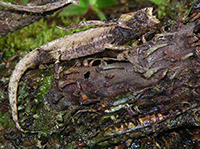
Visit to the National Park of Andasibe (Mantadia National Park)
The local organizers kindly offer the GB22 attendees the possibility to visit the National Park of Andasibe (Mantadia National Park) on Sunday 11 October 2015.
How to register
 Participation in this excursion requires pre-registration and should be done via the GB22 meeting registration system. The participation costs, which include travel expenses, entry to the park, guide fees and lunch, will be payable during the GB22 meeting in Antananarivo.
Participation in this excursion requires pre-registration and should be done via the GB22 meeting registration system. The participation costs, which include travel expenses, entry to the park, guide fees and lunch, will be payable during the GB22 meeting in Antananarivo.
The price for the tour is 30 Euro or 111,000 Ariary which must be paid to the local organizers during the meeting, before the excursion.
Programme
- Departure at Antananarivo Ivato: Please be at the Hotel Paon d'or at 6.15 (IMPORTANT: both meeting time and place have changed).
- The trip to the Andasibe Park is expected to take 2h 20 min.
- The proposed circuit (Circuit Rianasoa) for visitors takes about 2 hours on a trail of 1.5 km.
The trekking begins at 9 km from the park entrance. It is a journey that will lead you to a natural pool fed by a waterfall. Swimming is allowed in your swimsuits! Along the trail you may hear the cries of the Indri indri and see orchids in this exceptional forest ambiance. - Expected time of return to Antananarivo: 6 pm at the Hotel Paon d'or. However, due to heavy traffic there may be delays so please take this into consideration if you are flying out the same evening.
The National Park of Andasibe
 Mantadia National Park is in the Alaotra Mangoro region of Madagascar. It is known for its rare orchids that bloom in the forest, the Indri (Indri indri) that can be seen all year round, beautiful waterfalls and the famous cultural rituals of the inhabitants of the surrounding area. Mantadia is connected to the Zahamena National Park by an impressive forest corridor. GPS: 18 ° 28' South, 48 ° 28' East.
Mantadia National Park is in the Alaotra Mangoro region of Madagascar. It is known for its rare orchids that bloom in the forest, the Indri (Indri indri) that can be seen all year round, beautiful waterfalls and the famous cultural rituals of the inhabitants of the surrounding area. Mantadia is connected to the Zahamena National Park by an impressive forest corridor. GPS: 18 ° 28' South, 48 ° 28' East.
Mantadia and the Special Reserve of Andasibe Mantadia Analamazaotra form the Andasibe Mantadia complex. These two protected areas were once identical but unfortunately the human pressures have separated them. Mantadia covers 15,480 ha
The best of Mantadia's fauna
- The Aye-Aye or Daubentonia madagascariensis. This endemic lemur is known as being the strangest and most archaic of the lemurs. Found in the forests of Mantadia, it is one of the true living fossils of the animal kingdom.
- Calumma parsonii uroplatus. This is the largest chameleon of Madagascar. You will see it in the Mantadia Park and the Special Reserve of Analamazaotra in the hot season ... if you can distinguish it from the tree that shelters it! Indeed, this chameleon has a camouflage worthy of the army!
- The Eulemur fulvus or Varika mavo. This cathemeral lemur (active both day and night) likes to live in groups in the Special Reserve and the National Park of Analamazoatra Mantadia. It can be seen all year round, in forests and even at roadsides, especially when the Chinese guava bears fruit!
- Motacilla flaviventris, the Madagascan Wagtail, also known by its Malagasy names Triotrio and Pila. It is a Malagasy endemic bird.
- The Boa manditra or just "manditra" in Malagasy. A spectacular snake which for many Madagascans is associated with both respect and terror.
- Indri indri, the largest of the living lemurs. It is a monogamous species, and territorial folivore with a peculiar territorial call that can be heard early in the morning every day.
- The Madagascar Baza, Aviceda madagascariensis, a diurnal bird of prey that is very difficult to observe, but common to Mantadia.
- Madagascan Yellowbrow, Crossleyia xanthophrys, terrestrial and threatened (NT) is easy to observe in this site.
Other lemur species to be found at Mantandia include Eulemur rubriventer, Avahis and Cheirogaleus. For information, in 2007, the diademed sifaka (as well as the black-and-white ruffed lemur) was reintroduced to Andasibe Mantadia.
The best of Mantadia's flora

- The Orchids, endemic plants of Madagascar, of which some species like Cymbidiella falcigera grow in the Special Reserve of Analamazoatra and the Mantadia National Park. Orchids can be seen all year round and they bloom between October and February.
- The Pandanus sp or Vakoana. The large leaves of this endemic plant of Madagascar are micro-habitats for some species of frogs. The people of Vakoana use it to build their huts. This plant can be seen in the Mantadia National Park and Reserve of Analamazaotra all year.
- Cyathea sp or Fanjàna. These are tree ferns with broad leaves. The roots of this plant are used in the manufacturing of pots. The Fanjàna grows year-round in the Special Reserve of Analamazoatra and the Mantadia National Park.
- Tambourissa sp or Ambora. This rot-proof tree is used by the inhabitants of the region in construction. It can be seen all year in the Mantadia National Park and in the special reserve of Analamazaotra.
Travel smart ...
For your stay in Mantadia, please wear clothing suited to the humid forest, a raincoat and non-slip footwear. Bring insect repellant and a bag for carrying your rubbish out of the park. Equip yourself with a bottle of mineral water. A picnic pack can be ordered in advance from the welcome center of the Park. The nearest banks are in Moramanga. Andasibe and Moramanga have a health center clinics and a hospital.
Mantadia and Andasibe are covered by the telephone network of Telma, Zain and Orange and have a cybercafe for your internet connections. Moramanga has a communal information center (with Internet, photocopy, fax, scanner ...).


